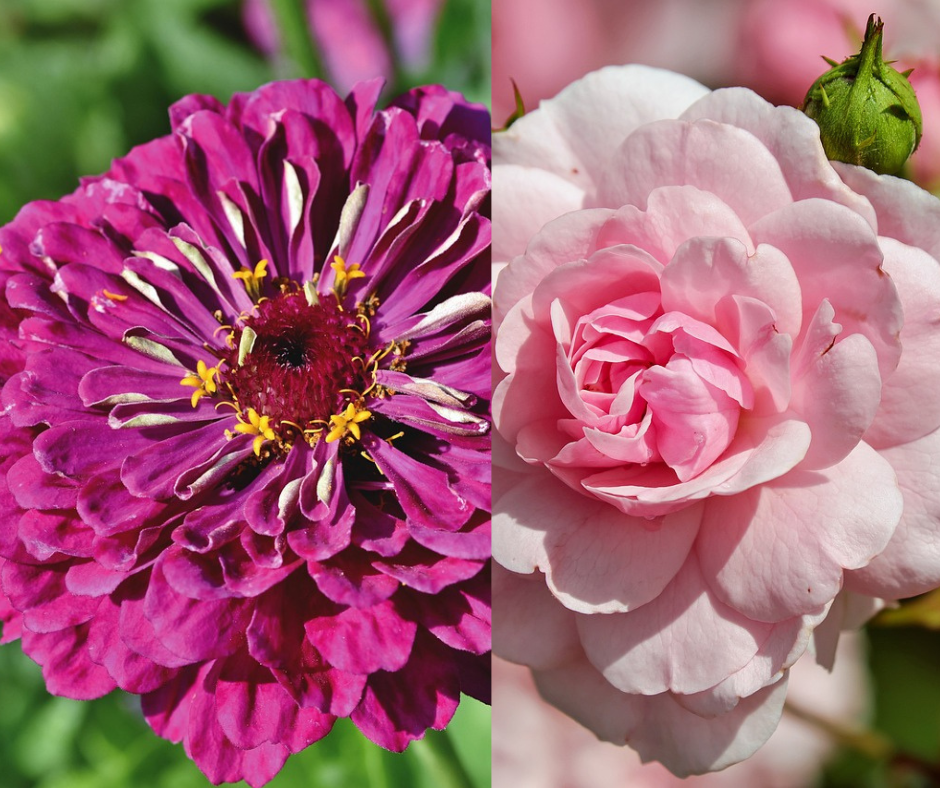
Zinnias and roses, a seemingly unlikely duo, weave together a tapestry of vibrant hues and captivating scents, captivating the hearts of gardeners worldwide. While their individual beauty is undeniable, the synergy they create when planted together is truly breathtaking. This guide delves into the secrets of cultivating a flourishing zinnia and rose garden, transforming your outdoor space into a masterpiece of color and fragrance.
Understanding the Allure: Why Zinnias and Roses Make Perfect Partners
Despite their contrasting appearances, zinnias and roses share a symbiotic relationship that benefits both blooms. Here’s a glimpse into what makes them such compatible companions:
- Thriving in Similar Conditions: Both these flowers flourish in well-drained, fertile soil and require ample sunlight, making them ideal neighbors in terms of their environmental needs.
- Staggering Growth Habits: Zinnias, with their upright and bushy growth pattern, provide much-needed shade for the delicate rose blooms during the hottest parts of the day, protecting them from scorching sunlight.
- A Feast for the Senses: The vibrant colors of zinnias, ranging from fiery oranges to delicate pinks, complement the classic elegance of roses, creating a visually stunning display. Additionally, the sweet fragrance of roses mingles beautifully with the subtle, yet pleasant aroma of zinnias, creating a delightful olfactory experience.
- A Strategic Alliance Against Pests: Zinnias, with their unique pest-repellent properties, can help deter harmful insects away from your rose bushes, promoting a healthier overall garden environment.
Unveiling the Secrets: Cultivating a Flourishing Zinnia and Rose Haven
Now that we’ve established the magic behind this floral partnership, let’s delve into the practical steps of creating your own zinnia and rose haven:
1. Choosing the Perfect Location:
- Sunlight: Select a location that receives at least 6-8 hours of direct sunlight daily.
- Soil: Ensure the soil is well-draining and fertile. Amending the soil with compost or aged manure can improve drainage and nutrient content.
- Spacing: When planting, consider the mature size of both plants. Allow adequate space between zinnias and roses to prevent overcrowding and ensure proper air circulation. Aim for 12-18 inches between zinnia plants and 2-3 feet between rose bushes.
2. Selecting the Stars of the Show:
- Zinnias: With a vast array of varieties to choose from, explore options like the ‘Profusion’ series for a profusion of blooms, or the ‘Giant’ series for impressive flower size. Consider incorporating different colors to create a vibrant tapestry.
- Roses: Opt for rose varieties that are known for their disease resistance, such as the Knock Out series or the Flower Carpet series. Choose colors that complement the zinnias you’ve selected, creating a harmonious color scheme.
3. Planting with Precision:
- Planting Time: The ideal planting time depends on your local climate. Generally, plant zinnias and roses after the danger of frost has passed in the spring.
- Planting Zinnias: Sow zinnia seeds directly into the prepared soil after the last frost date. Alternatively, you can start them indoors 4-6 weeks before transplanting them outdoors.
- Planting Roses: Carefully dig holes that are deep enough to accommodate the entire root ball of the rose bush. Gently place the rose bush in the hole, ensuring the graft union (the swollen area where the rose stem and rootstock meet) is positioned slightly above the soil surface. Backfill the hole with soil, tamping it down gently.
4. Nurturing Your Blooms:
- Watering: Water your zinnia and rose garden regularly, especially during hot and dry periods. Aim to provide deep watering, allowing the water to reach the roots. Avoid overwatering, as this can lead to root rot.
- Fertilizing: Feed your zinnia and rose plants with a balanced fertilizer throughout the growing season. Follow the specific instructions on the fertilizer packaging for optimal results.
- Deadheading: Regularly deadhead both zinnias and roses by removing spent blooms. This encourages continuous blooming and promotes a tidier appearance.
4. Nurturing Your Blooms:
While following these guidelines will undoubtedly lead you closer to cultivating a flourishing zinnia and rose garden, remember that gardening is an ongoing journey of learning and adaptation. Embrace the unexpected, be willing to experiment, and most importantly, enjoy the process of creating your own personal floral haven.
